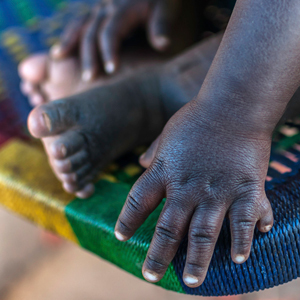Working group aims to raise awareness, build collaborations

Nearly 120,000 babies are born with a birth defect* each year in the United States—one baby every 4.5 minutes, according to the Centers for Disease Control and Prevention.
To address this important public health concern, scientists across NIH have banded together through the Trans-NIH Structural Birth Defects Working Group to raise awareness about birth defects and explore research collaborations.
Birth defects are structural or functional abnormalities present at birth. Structural birth defects can include, among other variations:
- Cleft lip or cleft palate
- Heart defects, such as missing or misshapen valves
- Abnormal limbs, such as a clubfoot or extra fingers or toes (called polydactyly)
- Neural tube defects—birth defects of the brain or spinal cord—such as spina bifida
“Whether we realize it or not, birth defects have an impact on us all,” said Lorette Javois, Ph.D., of NICHD’s Developmental Biology and Structural Variation Branch and chair of the Working Group. “If we aren’t personally affected, we know a family member, friend, or coworker who has been.”
We recently checked in with Dr. Javois and other members of the Working Group for their perspectives on the importance of birth defects research and future directions.
Trans-NIH Structural Birth Defects Working Group Meeting, December 2014
The Working Group recently brought together developmental biologists and physicians to discuss ways to build stronger collaborations.
Watch a video of their meeting or read their best practices for establishing basic science and clinical collaborations (PDF - 249 KB).
Here’s what they had to say:
“Because a birth defect is something that has gone wrong during the course of development, it can provide important insights into how the body develops and how we can correct other diseases that relate to the brain and the body.”
Tom Greenwell, Ph.D., National Eye Institute“Birth defects research has appeal on several levels: the impact of birth defects on individual people, the more abstract ‘burden’ on the health care system, and the intellectual appeal that comes from birth defects research being the human side of developmental biology.”
Steven B. Scholnick, Ph.D., National Institute of Dental and Craniofacial Research“Better coordination will lead to more efficient use of research dollars, which is especially important as research budgets tighten. The Working Group hopes to extend its role as coordinator beyond the NIH, helping to set a research agenda to better understand, treat, and prevent birth defects. In my mind, funding this research is one of the finest examples of NIH accomplishing its mission to apply fundamental knowledge about the nature of living systems to enhance health and reduce disability.”
Bill Dunty, Ph.D., National Institute on Alcohol Abuse and Alcoholism“Rapid advances in technology, including genome-sequencing and the development of induced pluripotent stem cells (iPSCs), put the field of birth defects research in a position to make great strides forward.”
Carol J. Blaisdell, M.D., National Heart, Lung, and Blood Institute
While the Working Group members recognize that there is a great deal of work left to do in birth defects research, they agree that the future is bright. As Dr. Javois put it, “With more collaborative efforts between basic scientists and physician scientists, I anticipate significant progress in gene discovery, understanding of genetic pathways and networks, diagnostics, improved personalized treatment options, and cures.”
More Information
- National Birth Defects Prevention Network: National Birth Defects Prevention Month

- Trans-NIH Structural Birth Defects Working Group
- NICHD Resources:
- Division of Extramural Research
- Division of Intramural Population Health Research (DIPHR)
- Related A to Z Topics:
- NICHD Efforts Related to Birth Defects:
- Selected Previous NICHD Spotlights on Birth Defects:
- It’s in the DNA: Animal Models Offer Clues to Human Development
- NICHD-Supported Research Sheds Light on a Family of Genes Involved in Dyslexia, Respiratory Health, and Organ Position
- Understanding Typical & Atypical Development: Research at the Heart of the NICHD Mission
- Spina Bifida Surgery in the Womb Decreases Complications
- NICHD News Releases on Birth Defects
Originally Posted: January 20, 2015
* The NICHD is aware that the term “birth defects” carries negative connotations and that the term does not reflect the many abilities and talents of those affected by these problems. Communities are discussing alternative terms for describing these problems. Because this article is about structural birth defects, and until a consensus is reached, this article uses the terms “birth defect” and “structural variation.”

 BACK TO TOP
BACK TO TOP